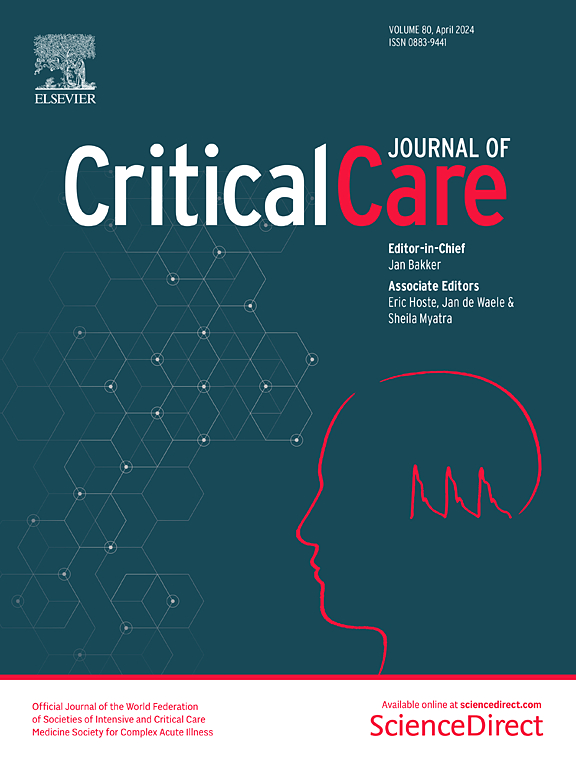与健康相关的生活质量与危重疾病幸存者患者报告和代理报告的残疾相关:ERIC试验的二次分析
IF 8.8
1区 医学
Q1 CRITICAL CARE MEDICINE
引用次数: 0
摘要
扩大危重病幸存者的随访服务需要简短可靠的成套工具。世界卫生组织残疾评估表(WHODAS)2.0 和欧洲量表五维五级(EQ-5D-5L)分别被推荐用于评估残疾和与健康相关的生活质量(HrQoL)。由于它们可能测量部分重叠的结构,因此我们评估了它们之间的关系。我们对多中心群组随机对照重症监护后增强康复(ERIC)试验(ClinicalTrials.gov:NCT03671447)进行了二次分析。在重症监护病房出院后 6 个月的随访中,危重病幸存者和护理人员填写了 EQ-5D-5L、患者报告和代理报告的 12 项 WHODAS 2.0。我们采用局部多项式回归、相关系数和线性回归来分析 EQ-5D-5L 和 WHODAS 2.0 之间的总体关系和特定领域关系。我们分析了 700 名患者,他们的 EQ-5D-5L 指数中位值为 0.81 [IQR 0.52 至 0.94],患者报告的 WHODAS 2.0 总分中位值为 11 [IQR 3 至 23],代理报告的 WHODAS 2.0 总分中位值为 16 [IQR 6 至 28]。EQ-5D-5L指数值与患者报告(Spearman:- 0.84 [95% CI - 0.86 to - 0.82])和代理报告(Spearman:- 0.70 [- 0.76 to - 0.64])的WHODAS 2.0总分高度相关。相应的领域也高度相关,患者报告的 WHODAS 2.0 与 EQ-5D-5L 的吻合程度高于代理报告的 WHODAS 2.0。我们发现这两种工具都存在上限和下限效应,这表明它们在检测轻度残疾和高 HrQoL 方面存在局限性。在多变量线性回归中,患者报告和委托人报告的 WHODAS 2.0 总分(均为 - 0.02 [95% CI - 0.02 to - 0.02],p < 0.01)以及 WHODAS 2.0 的行动能力、自理能力和生活活动领域得分是 EQ-5D-5L 指数值和各自 EQ-5D-5L 领域得分的预测因子。我们的研究结果表明,患者报告和代理报告的 WHODAS 2.0 与 EQ-5D-5L 之间具有高度相关性,尤其是在其相应的领域。为了节省重症监护室术后评估的费用,可能没有必要同时使用这两种工具。本文章由计算机程序翻译,如有差异,请以英文原文为准。
Health-related quality of life correlates with patient-reported and proxy-reported disability in critical illness survivors: a secondary analysis of the ERIC trial
Expanding follow-up services for survivors of critical illness requires short and reliable instrument sets. The WHO Disability Assessment Schedule (WHODAS) 2.0 and the EuroQol 5-Dimensions 5-Level (EQ-5D-5L) are recommended to assess disability and health-related quality of life (HrQoL), respectively. As they may measure partially overlapping constructs, we assessed their relationship. We conducted a secondary analysis of the multicenter cluster-randomized controlled Enhanced Recovery after Intensive Care (ERIC) trial (ClinicalTrials.gov: NCT03671447). At follow-ups scheduled 6 months after ICU discharge, critical illness survivors and caregivers completed the EQ-5D-5L, the patient-reported and the proxy-reported 12-item WHODAS 2.0. We employed local polynomial regressions, correlation coefficients, and linear regressions to analyze the global and domain-specific relationships between the EQ-5D-5L and the WHODAS 2.0. We analyzed 700 patients with a median EQ-5D-5L index value of 0.81 [IQR 0.52 to 0.94], a median patient-reported WHODAS 2.0 sum score of 11 [IQR 3 to 23], and a median proxy-reported WHODAS 2.0 sum score of 16 [IQR 6 to 28]. The EQ-5D-5L index value highly correlated with patient-reported (Spearman: − 0.84 [95% CI − 0.86 to − 0.82]) and proxy-reported (Spearman: − 0.70 [− 0.76 to − 0.64]) WHODAS 2.0 sum scores. Corresponding domains were also highly correlated, with the patient-reported WHODAS 2.0 aligning more closely with the EQ-5D-5L than the proxy-reported WHODAS 2.0. We found ceiling and floor effects for both instruments, indicating limitations for detecting mild disabilities and high HrQoL. In multivariable linear regressions, the patient-reported and proxy-reported WHODAS 2.0 sum scores (both − 0.02 [95% CI − 0.02 to − 0.02], p < 0.01) and WHODAS 2.0 domain scores for mobility, self-care, and life activities were predictors of the EQ-5D-5L index value and respective EQ-5D-5L domain scores. Our results suggest a high correlation between the patient-reported and proxy-reported WHODAS 2.0 and the EQ-5D-5L, particularly in their corresponding domains. To economize post-ICU assessments, there may be no need to use both instruments simultaneously.
求助全文
通过发布文献求助,成功后即可免费获取论文全文。
去求助
来源期刊

Critical Care
医学-危重病医学
CiteScore
20.60
自引率
3.30%
发文量
348
审稿时长
1.5 months
期刊介绍:
Critical Care is an esteemed international medical journal that undergoes a rigorous peer-review process to maintain its high quality standards. Its primary objective is to enhance the healthcare services offered to critically ill patients. To achieve this, the journal focuses on gathering, exchanging, disseminating, and endorsing evidence-based information that is highly relevant to intensivists. By doing so, Critical Care seeks to provide a thorough and inclusive examination of the intensive care field.
 求助内容:
求助内容: 应助结果提醒方式:
应助结果提醒方式:


